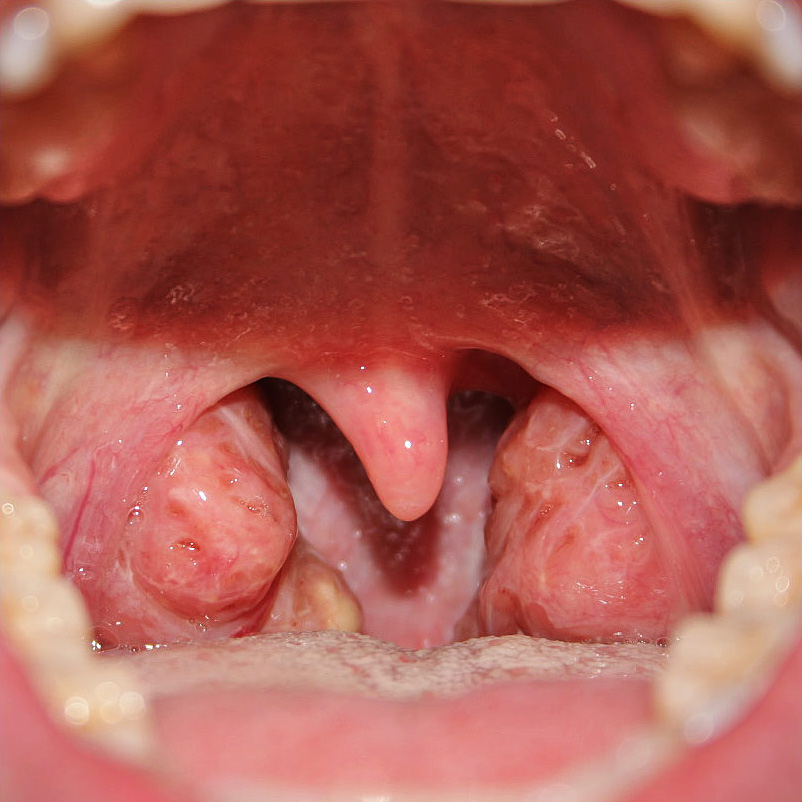Peritonsillar abscess
(Redirected from Tonsillar abscess)
Editor-In-Chief: Prab R Tumpati, MD
Obesity, Sleep & Internal medicine
Founder, WikiMD Wellnesspedia &
W8MD medical weight loss NYC and sleep center NYC
| Peritonsillar abscess | |
|---|---|
| Synonyms | Quinsy |
| Pronounce | N/A |
| Specialty | N/A |
| Symptoms | Sore throat, fever, drooling, trismus, muffled voice |
| Complications | Airway obstruction, aspiration pneumonia, sepsis |
| Onset | Typically young adults |
| Duration | |
| Types | N/A |
| Causes | Bacterial infection |
| Risks | Tonsillitis, smoking, chronic lymphocytic leukemia |
| Diagnosis | Physical examination, ultrasound, CT scan |
| Differential diagnosis | Epiglottitis, retropharyngeal abscess, tonsillitis |
| Prevention | |
| Treatment | Antibiotics, surgical drainage |
| Medication | Penicillin, clindamycin |
| Prognosis | Generally good with treatment |
| Frequency | 30 per 100,000 per year |
| Deaths | N/A |
Peritonsillar abscess Peritonsillar abscess, often abbreviated as PTA, is a clinical condition characterized by the collection of pus in the peritonsillar space, a potential space surrounding the palatine tonsils. It is a complication of acute tonsillitis and is one of the most common deep neck infections.
Pathophysiology[edit | edit source]
The pathophysiology Pathophysiology of a peritonsillar abscess is generally initiated by acute tonsillitis, leading to inflammation and subsequent pus formation in the peritonsillar space. The infection often involves a mixture of aerobic and anaerobic bacteria, with the most common pathogens being group A streptococcus Streptococcus pyogenes and Fusobacterium.
Clinical Presentation[edit | edit source]
Patients with a peritonsillar abscess often present with severe sore throat, fever, drooling, and difficulty swallowing (odynophagia) Odynophagia. Trismus, or reduced opening of the jaw, is also common due to the involvement of the pterygoid muscles. The voice of the patient may become muffled or exhibit a "hot potato" voice, due to the swelling of the tissues around the tonsils.
Diagnosis[edit | edit source]
Diagnosis of a peritonsillar abscess usually involves a thorough history and physical examination, including an oral examination. During oral examination, one might observe a swollen, displaced uvula and an enlarged, erythematous tonsil with or without visible pus. Additional diagnostic tools such as computed tomography (CT) scan Computed tomography or ultrasound can be used to confirm the diagnosis and rule out other differential diagnoses such as peritonsillar cellulitis.
Treatment[edit | edit source]
The primary treatment of a peritonsillar abscess involves drainage of the abscess, either through needle aspiration, incision and drainage, or tonsillectomy Tonsillectomy, along with antibiotic therapy to cover the common causative organisms. Pain control and hydration are also important aspects of management.
Prognosis[edit | edit source]
With timely and appropriate treatment, the prognosis for a peritonsillar abscess is generally excellent. However, potential complications can arise if the condition is left untreated, including the spread of infection to deeper neck tissues and airway obstruction.
Epidemiology[edit | edit source]
Peritonsillar abscesses are relatively common, particularly among adolescents and young adults. They can occur at any age but are less frequent in younger children and the elderly.
References[edit | edit source]
- Herzon, FS. (1995). "Harris P. Mosher Award thesis. Peritonsillar abscess: incidence, current management practices, and a proposal for treatment guidelines". Laryngoscope.
- Powell, J., Wilson, J.A. (2012). "An evidence-based review of peritonsillar abscess". Clinical Otolaryngology.
- Walker, P., Gillies, D. (2007). "Primary versus secondary incision and drainage for peritonsillar abscess". Cochrane Database of Systematic Reviews.
External Links[edit | edit source]
- [American Academy of Otolaryngology – Head and Neck Surgery - Tonsils and Adenoids](https://www.entnet.org/content/tonsils-and-adenoids)
- National Health Service (NHS) - Quinsy
| This article is a medical stub. You can help WikiMD by expanding it! | |
|---|---|
| Diseases of the respiratory system | ||||||||||||||||||||||||||||||||||||||
|---|---|---|---|---|---|---|---|---|---|---|---|---|---|---|---|---|---|---|---|---|---|---|---|---|---|---|---|---|---|---|---|---|---|---|---|---|---|---|
|
Search WikiMD
Ad.Tired of being Overweight? Try W8MD's physician weight loss program.
Semaglutide (Ozempic / Wegovy and Tirzepatide (Mounjaro / Zepbound) available.
Advertise on WikiMD
|
WikiMD's Wellness Encyclopedia |
| Let Food Be Thy Medicine Medicine Thy Food - Hippocrates |
Translate this page: - East Asian
中文,
日本,
한국어,
South Asian
हिन्दी,
தமிழ்,
తెలుగు,
Urdu,
ಕನ್ನಡ,
Southeast Asian
Indonesian,
Vietnamese,
Thai,
မြန်မာဘာသာ,
বাংলা
European
español,
Deutsch,
français,
Greek,
português do Brasil,
polski,
română,
русский,
Nederlands,
norsk,
svenska,
suomi,
Italian
Middle Eastern & African
عربى,
Turkish,
Persian,
Hebrew,
Afrikaans,
isiZulu,
Kiswahili,
Other
Bulgarian,
Hungarian,
Czech,
Swedish,
മലയാളം,
मराठी,
ਪੰਜਾਬੀ,
ગુજરાતી,
Portuguese,
Ukrainian
Medical Disclaimer: WikiMD is not a substitute for professional medical advice. The information on WikiMD is provided as an information resource only, may be incorrect, outdated or misleading, and is not to be used or relied on for any diagnostic or treatment purposes. Please consult your health care provider before making any healthcare decisions or for guidance about a specific medical condition. WikiMD expressly disclaims responsibility, and shall have no liability, for any damages, loss, injury, or liability whatsoever suffered as a result of your reliance on the information contained in this site. By visiting this site you agree to the foregoing terms and conditions, which may from time to time be changed or supplemented by WikiMD. If you do not agree to the foregoing terms and conditions, you should not enter or use this site. See full disclaimer.
Credits:Most images are courtesy of Wikimedia commons, and templates, categories Wikipedia, licensed under CC BY SA or similar.
Contributors: Prab R. Tumpati, MD





